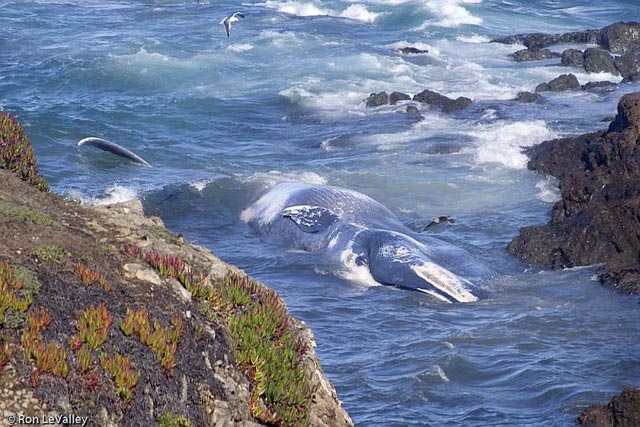
Goley, the marine mammal stranding coordinator in Northern California and a biology professor, jumped into action. She, along with the National Marine Fisheries Service, dispatched a team of professionals, including HSU faculty and students, to the site.
Biology professor Thor Holmes and student Amber Anderson were just two of the team members to be dispatched to the Fort Bragg beach where the whale was found. The team got to work assessing the situation and taking field data before deciding their next step.
“One of the best experiences I have ever had was seeing those two students’ faces as they came upon that whale,” says Holmes. “It was an astonishing experience for me.”
The stranding of any marine mammal might be considered a sad event, but this incident turned into a learning experience for HSU students as well those from other colleges and universities across Northern California. More than 20 students and faculty from HSU, and others from Sonoma State and College of the Redwoods, assisted in the necropsy.
The species of the whale, the type of injury and the location of its stranding were some determining factors about whether to conduct a necropsy. This whale was struck by an NOAA mapping survey boat and subsequently beached due to its injury. Because this was an isolated stranding, the team gave the go ahead for other research teams as well as students and community members to participate. “Large whales typically die quickly on the beach either from the injuries or the illnesses that brought them there,” said Dr. Goley.
Because it was a blue whale, endangered and protected from hunting, the event generated a lot of interest from various organizations including a South African scientist interested in the whale’s larynx. “This whale caught the attention of many research groups from around the world due to the species, its relatively good condition and our active participation in the necropsy,” said Dr. Goley, Samples were collected for researchers studying the sound production mechanisms of great whales, hearing in blue whales, the evolution of hair in mammals, and the genetic stock of the whale among others.
HSU also played a supporting role in getting the whale to its final destination. At the request of the City of Fort Bragg, after the initial harvesting was done, the whale remains were buried in the forest of Mendocino County to be cleaned by bugs and micro-organisms.
The remains will be exhumed after it has adequately decomposed so that the skeleton may be displayed in Mendocino County.
Blue whale photos courtesy HSU Alum Ron LeValley. For more photos, visit Ron LeValley Photography